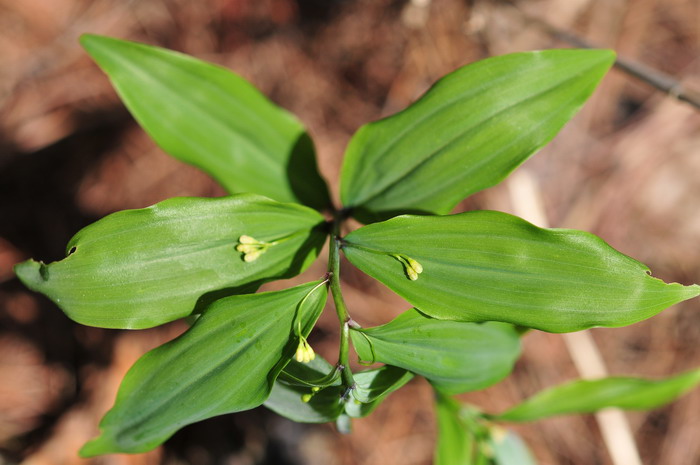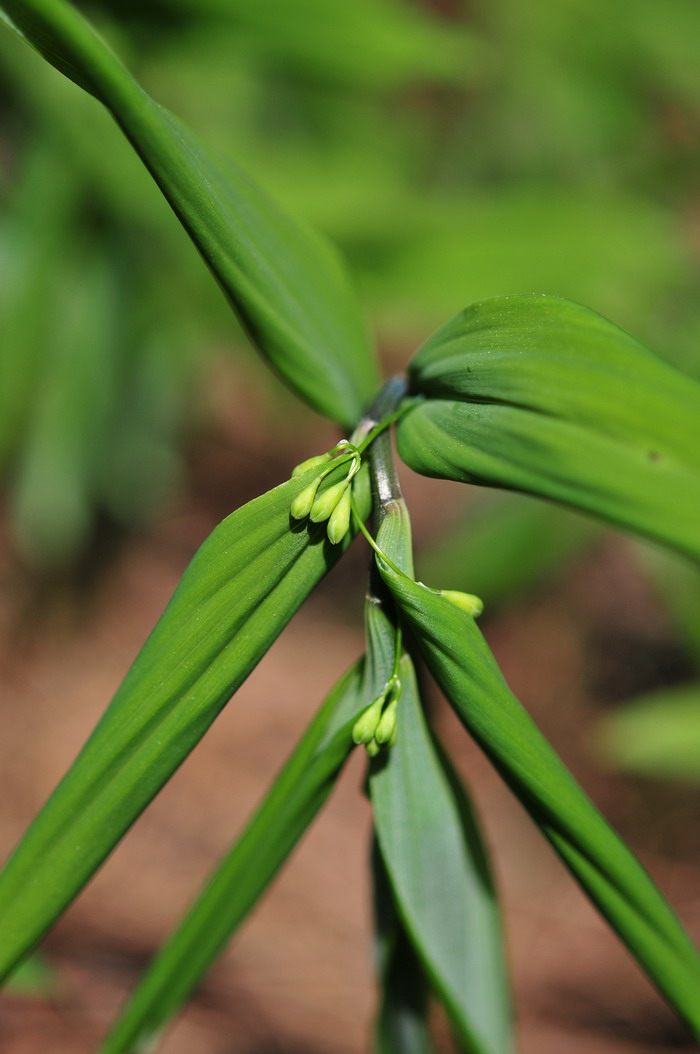多花黄精Polygonatum cyrtonema
中文名(Chinese Name):多花黄精
学名(Scientific Name):Polygonatum cyrtonema Hua
英文名(English Common Name):
别名(Chinese Common Name):长叶黄精、山姜
异名(Synonym):Polygonatum brachynema Hand.-Mazz. Polygonatum henryi Diels Polygonatum multiflorum var. longifolium Merr. Polygonatum martinii H. Lév. Polygonatum martini H.Lév. Polygonatum japonicum var. formosanum Hayata
科属(Family & Genus):百合科(Liliaceae)黄精属
形态特征(Description):根状茎肥厚,通常连珠状或结节成块,少有近圆柱形,直径1-2厘米。茎高50-100厘米,通常具10-15枚叶。叶互生,椭圆形、卵状披针形至矩圆状披针形,少有稍作镰状弯曲,长10-18厘米,宽2-7厘米,先端尖至渐尖。花序具(1-)2-7(-14)花,伞形,总花梗长1-4(-6)厘米,花梗长0.5-1.5(-3)厘米;苞片微小,位于花梗中部以下,或不存在;花被黄绿色,全长18-25毫米,裂片长约3毫米;花丝长3-4毫米,两侧扁或稍扁,具乳头状突起至具短绵毛,顶端稍膨大乃至具囊状突起,花药长3.5-4毫米;子房长3-6毫米,花柱长12-15毫米。浆果黑色,直径约1厘米,具3-9颗种子。花期5-6月,果期8-10月。
分布(Distribution):产四川、贵州、湖南、湖北、河南、江西、安徽、江苏、浙江、福建、广东、广西。生海拔500-2100米林下、灌丛或山坡阴处。
用途(Use):南方地区作黄精用。
引自植物志英文版:FOC Vol. 24 Page 227
Polygonatum cyrtonema Hua, J. Bot. (Morot). 6: 393. 1892.
多花黄精 duo hua huang jing| Liliaceae | Polygonatum
Polygonatum brachynema Handel-Mazzetti; P. henryi Diels; P. martini H. Léveillé; P. multiflorum Allioni var. longifolium Merrill.
Rhizome usually moniliform or tuberous moniliform, rarely subterete, 1--2 cm thick. Stem erect, 50--100 cm, glabrous. Leaves 10--15, alternate; petiole short; leaf blade elliptic to oblong-lanceolate, occasionally falcate, 10--18 × 2--7 cm, apex usually acuminate. Inflorescences umbel-like, (1 or)2--7(--14)-flowered; peduncle 1--4(--6) cm; bracts borne on proximal part of pedicel, small, or absent. Flowers pendulous; pedicel 0.5--1.5(--3) cm. Perianth yellowish green, campanulate-cylindric, 1.8--2.5 cm; lobes ca. 3 mm. Filaments slightly compressed, 3--4 mm, papillose or shortly cottony, apically slightly dilated or saccate-convex; anthers 3.5--4 mm. Ovary 3--6 mm. Style 1.2--1.5 cm. Berries black, ca. 1 cm in diam., 3--9-seeded. Fl. May--Jun, fr. Aug--Oct. 2 n = 18*, 20*, 22*.
* Forests, thickets, shaded slopes; 500--2100 m. Anhui, Fujian, Guangdong, Guangxi, Guizhou, Henan, Hubei, Hunan, Jiangsu, Jiangxi, ?S Shaanxi (Qin Ling), Sichuan, Zhejiang.
Polygonatum zhejiangense X. J. Xue & H. Yao (Bull. Bot. Res., Harbin 14: 242. 1994) seems to be related to, or conspecific with, P. cyrtonema but its leaves are cirrose at the apex. No specimens have been seen by the present authors. Polygonatum jinzhaiense D. C. Zhang & J. Z. Shao (in D. C. Zhang et al., Guihaia 20: 34. 2000) was recently described from W Anhui (Jinzhai Xian). Although the present authors have not seen the type specimen, it is evident from the description that P. jinzhaiense is similar to P. cyrtonema and P. arisanense in general, but differs from these two species in rhizome shape and the position of the thickening part along the filaments—characters which are usually stable in Polygonatum. Further studies are needed to clarify whether or not P. jinzhaiense is distinct.


(责任编辑:徐晔春)
学名(Scientific Name):Polygonatum cyrtonema Hua
英文名(English Common Name):
别名(Chinese Common Name):长叶黄精、山姜
异名(Synonym):Polygonatum brachynema Hand.-Mazz. Polygonatum henryi Diels Polygonatum multiflorum var. longifolium Merr. Polygonatum martinii H. Lév. Polygonatum martini H.Lév. Polygonatum japonicum var. formosanum Hayata
科属(Family & Genus):百合科(Liliaceae)黄精属
形态特征(Description):根状茎肥厚,通常连珠状或结节成块,少有近圆柱形,直径1-2厘米。茎高50-100厘米,通常具10-15枚叶。叶互生,椭圆形、卵状披针形至矩圆状披针形,少有稍作镰状弯曲,长10-18厘米,宽2-7厘米,先端尖至渐尖。花序具(1-)2-7(-14)花,伞形,总花梗长1-4(-6)厘米,花梗长0.5-1.5(-3)厘米;苞片微小,位于花梗中部以下,或不存在;花被黄绿色,全长18-25毫米,裂片长约3毫米;花丝长3-4毫米,两侧扁或稍扁,具乳头状突起至具短绵毛,顶端稍膨大乃至具囊状突起,花药长3.5-4毫米;子房长3-6毫米,花柱长12-15毫米。浆果黑色,直径约1厘米,具3-9颗种子。花期5-6月,果期8-10月。
分布(Distribution):产四川、贵州、湖南、湖北、河南、江西、安徽、江苏、浙江、福建、广东、广西。生海拔500-2100米林下、灌丛或山坡阴处。
用途(Use):南方地区作黄精用。
引自植物志英文版:FOC Vol. 24 Page 227
Polygonatum cyrtonema Hua, J. Bot. (Morot). 6: 393. 1892.
多花黄精 duo hua huang jing| Liliaceae | Polygonatum
Polygonatum brachynema Handel-Mazzetti; P. henryi Diels; P. martini H. Léveillé; P. multiflorum Allioni var. longifolium Merrill.
Rhizome usually moniliform or tuberous moniliform, rarely subterete, 1--2 cm thick. Stem erect, 50--100 cm, glabrous. Leaves 10--15, alternate; petiole short; leaf blade elliptic to oblong-lanceolate, occasionally falcate, 10--18 × 2--7 cm, apex usually acuminate. Inflorescences umbel-like, (1 or)2--7(--14)-flowered; peduncle 1--4(--6) cm; bracts borne on proximal part of pedicel, small, or absent. Flowers pendulous; pedicel 0.5--1.5(--3) cm. Perianth yellowish green, campanulate-cylindric, 1.8--2.5 cm; lobes ca. 3 mm. Filaments slightly compressed, 3--4 mm, papillose or shortly cottony, apically slightly dilated or saccate-convex; anthers 3.5--4 mm. Ovary 3--6 mm. Style 1.2--1.5 cm. Berries black, ca. 1 cm in diam., 3--9-seeded. Fl. May--Jun, fr. Aug--Oct. 2 n = 18*, 20*, 22*.
* Forests, thickets, shaded slopes; 500--2100 m. Anhui, Fujian, Guangdong, Guangxi, Guizhou, Henan, Hubei, Hunan, Jiangsu, Jiangxi, ?S Shaanxi (Qin Ling), Sichuan, Zhejiang.
Polygonatum zhejiangense X. J. Xue & H. Yao (Bull. Bot. Res., Harbin 14: 242. 1994) seems to be related to, or conspecific with, P. cyrtonema but its leaves are cirrose at the apex. No specimens have been seen by the present authors. Polygonatum jinzhaiense D. C. Zhang & J. Z. Shao (in D. C. Zhang et al., Guihaia 20: 34. 2000) was recently described from W Anhui (Jinzhai Xian). Although the present authors have not seen the type specimen, it is evident from the description that P. jinzhaiense is similar to P. cyrtonema and P. arisanense in general, but differs from these two species in rhizome shape and the position of the thickening part along the filaments—characters which are usually stable in Polygonatum. Further studies are needed to clarify whether or not P. jinzhaiense is distinct.
(责任编辑:徐晔春)
踩一下[1]

顶一下[4]